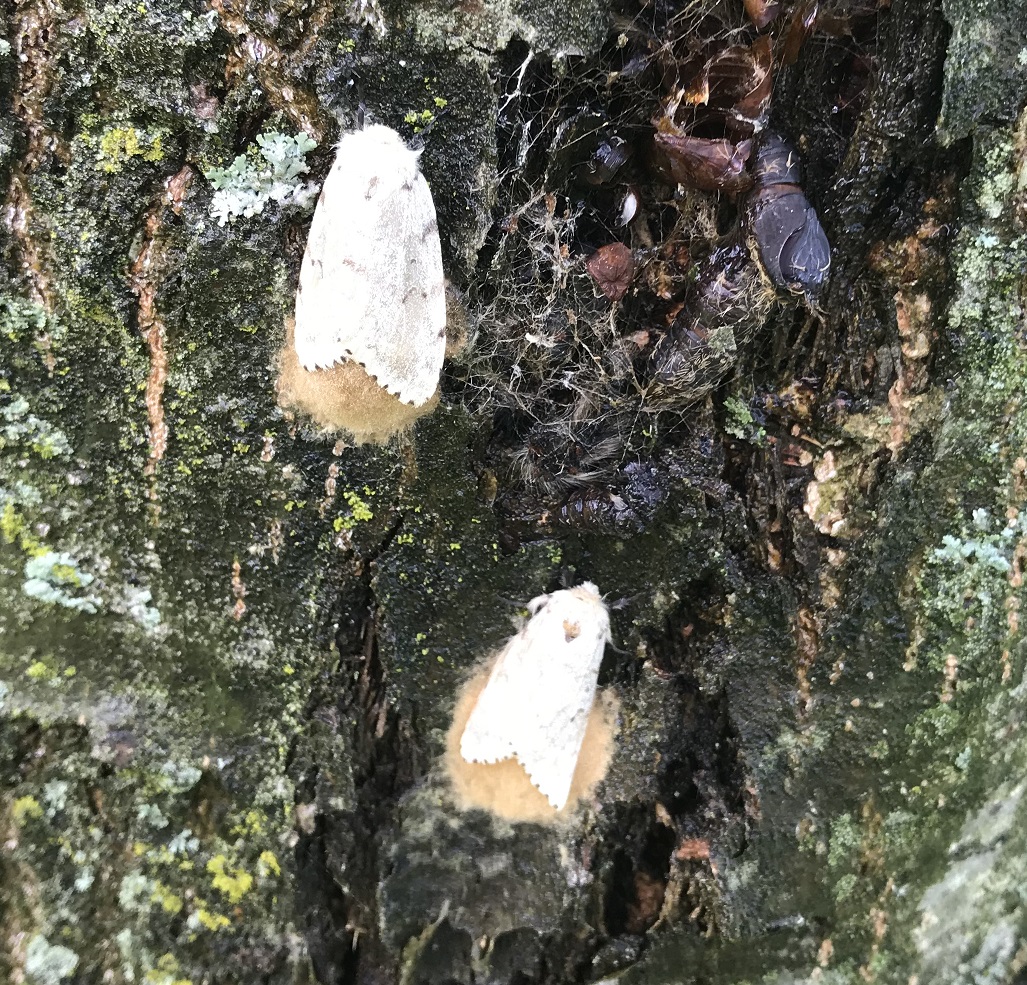Spongy moth (Lymantria dispar) is a highly cyclical non-native forest pest. Their caterpillars eat the leaves of a wide variety of trees. Oaks are a preferred species. High populations of spongy moth result in tree defoliation with potential impacts on tree and forest health. Their caterpillars are easy to identify. Mature caterpillars are hairy, about 6 cm long and have five pairs of blue dots and six pairs of red dots along their back.
Spongy (LDD) moth
In early 2022, the Entomological Society of Canada adopted 'spongy moth' as the new common name for Lymantria dispar. This replaces the name 'LDD moth' which was used temporarily as a replacement for the name 'gypsy moth'.
Many forests in the southern half of our watershed have had high levels of spongy moth for the past several years. A large increase in spongy moth populations was seen across much of the watershed and most of southern Ontario in 2020 and 2021. Close to 1.8 million hectares of forest defoliation occurred in Ontario in 2021 - over four times higher than other historical outbreaks. Outbreaks tend to occur in cycles with high populations generally not lasting more than 2 or 3 years.
Most healthy deciduous trees can survive a couple of years of leaf loss caused by spongy moth caterpillars. However, stressed trees, conifers and trees that are defoliated for several years can die. This can result in a decline in forest health due to losses in tree species diversity and from impacts on oak species which provide important habitat and food for wildlife.
Spongy Moth Aerial Spray Program

To lower the damage caused by spongy moth, we treated five of our properties with an organic pesticide in 2020 and 2021. Aerial applications occurred over portions of Pinehurst Lake and Brant conservation areas in both years while parts of Byng Island conservation area, FWR Dickson wilderness area and the Dryden Tract were treated only in 2020.
Tree defoliation and caterpillar levels were signficantly lower in these treated areas during the past two summers. These areas will not be retreated in 2022 as the current risk to overall forest health in these specific forests is believed to be low.
Across the watershed it is anticipated that spongy moth populations will drop within the next couple of years, however it is possible that significant pockets of defoliation could occur again in 2022. The best way to predict caterpillar levels in a specific forest area is through egg mass counts during winter or early spring.
Spongy moth caterpillar defoliation can result in tree stress, decline and mortality. Tree mortality is especially a risk when trees are defoliated two or more seasons in a row. Ecological impacts result from tree declines and mortality, especially in oaks. Oaks provide valuable food and habitat for a wide diversity of species. The current spongy moth infestation is also having a cumulative forest health impact on areas that have recently undergone significant tree losses due to emerald ash borer.
In addition, the presence of a large number of caterpillars and caterpillar droppings impacts people’s enjoyment of our natural areas. During outbreaks many trees lose almost all of their leaves and droppings accumulate on vehicles, trailers and other objects. During significant outbreaks, some people can experience skin, respiratory and eye irritation from airborne spongy moth hairs.
How does the GRCA decide whether to treat spongy moths?
Spongy moth populations tend to fluctuate in cycles with 10 – 15 years between outbreaks. Treatments are not intended to control the wider regional population of spongy moth. Outbreak cycles tend to decline naturally due to viral or fungal diseases that impact spongy moth. Treatments limit tree defoliation which lowers stress on trees and helps maintain overall forest health during outbreaks.
For many forests spongy moth presents a fairly low risk to forest health and treatments may not be required. The risk to forest health depends on the species of trees present, the population of spongy moth, the number of years the forest experiences defoliation, and whether the forest is being impacted to other stressors (diseases, insects, drought, or invasive species).
GRCA forests treated in 2020 and 2021 were selected because of their high oak content, the age\condition of many of the oaks, because they had been impacted by spongy moth for several years and egg mass counts were predicting moderate to severe defoliation.
What type of pesticide is used and is it safe?
The organic insecticide Foray® 48B, whose active ingredient is a bacteria Bacillus thuringiensis kurstaki (Btk), is applied by airplane or helicopter. Btk is a naturally occurring and widely distributed soil bacteria. Btk insecticides have been in use for over 30 years in Canada and around the world. Its use is approved by Health Canada including for aerial application over urban areas. Health Canada’s website states that it poses little threat to human health. When ingested, Btk impacts young moth and butterfly caterpillars. It is not toxic to bees and other insects, birds, fish, mammals or adult moths/butterflies. If not ingested, Btk degrades within several days. It does not impact moth and butterfly species, like monarchs, whose caterpillars emerge later in the season.
Can other methods be used to control spongy moth?
Manual methods, including the removal and destruction of egg masses and placing burlap and sticky bands on trees can help to minimize the impact of spongy moths on small and individual trees. These methods are ineffective when populations are high and over large forested areas. Individual tree injections of insecticides can also be used; however, they are also not practical across larger forests.
Contact Us
Grand River Conservation Authority
400 Clyde Road, PO Box 729
Cambridge, ON
N1R 5W6
Phone: 519-621-2761
Toll Free: 1-866-900-4722
grca@grandriver.ca
